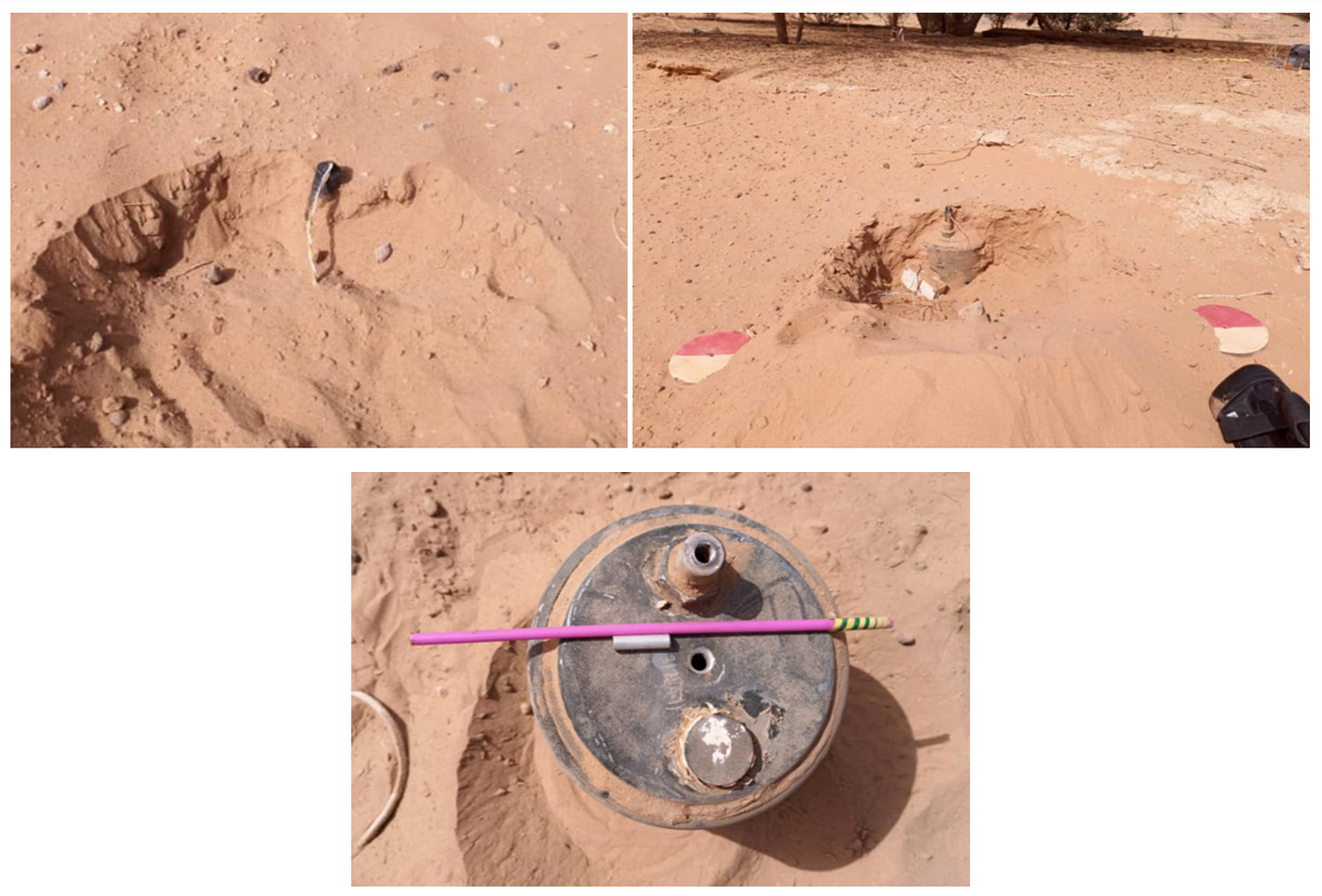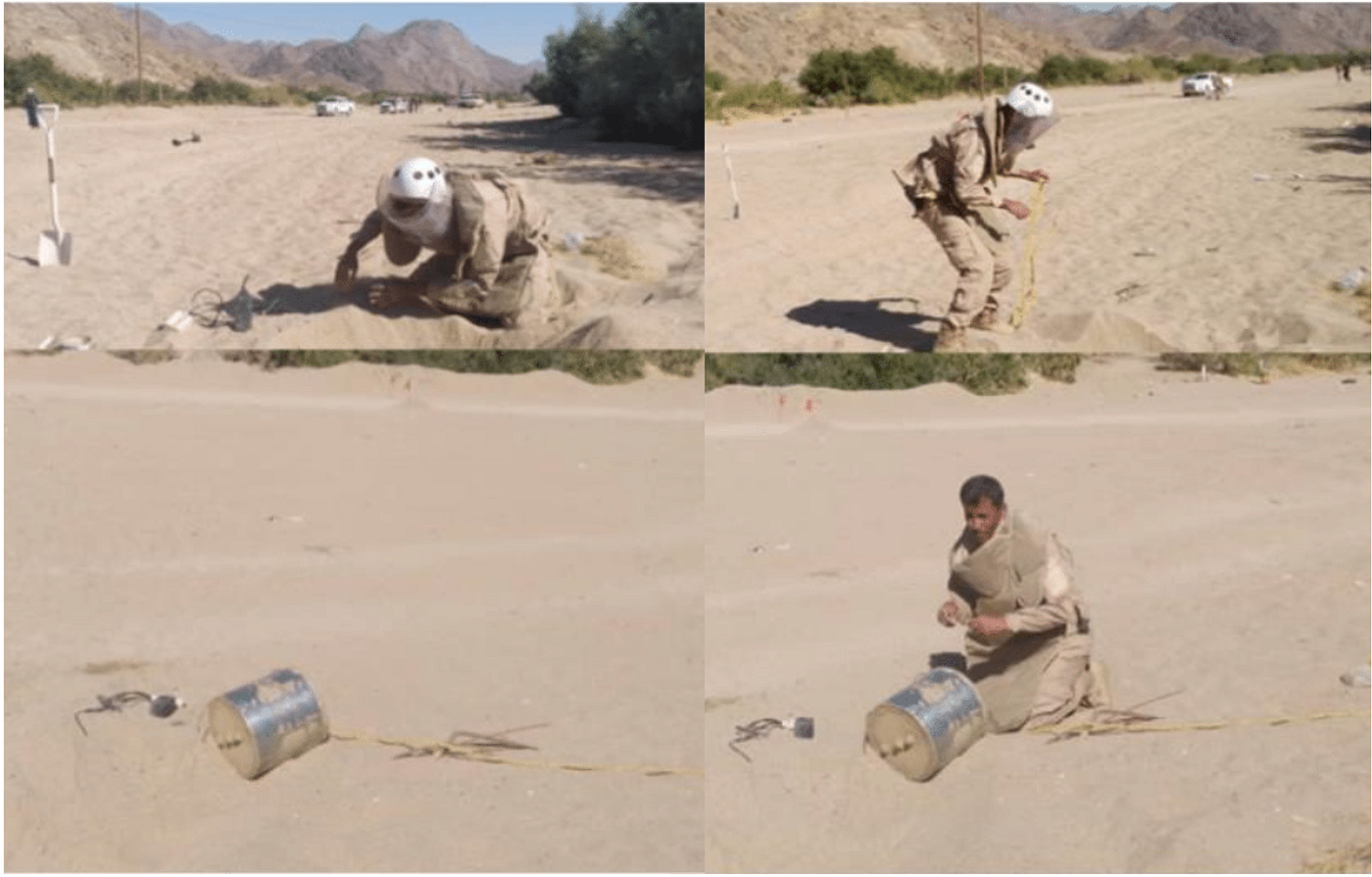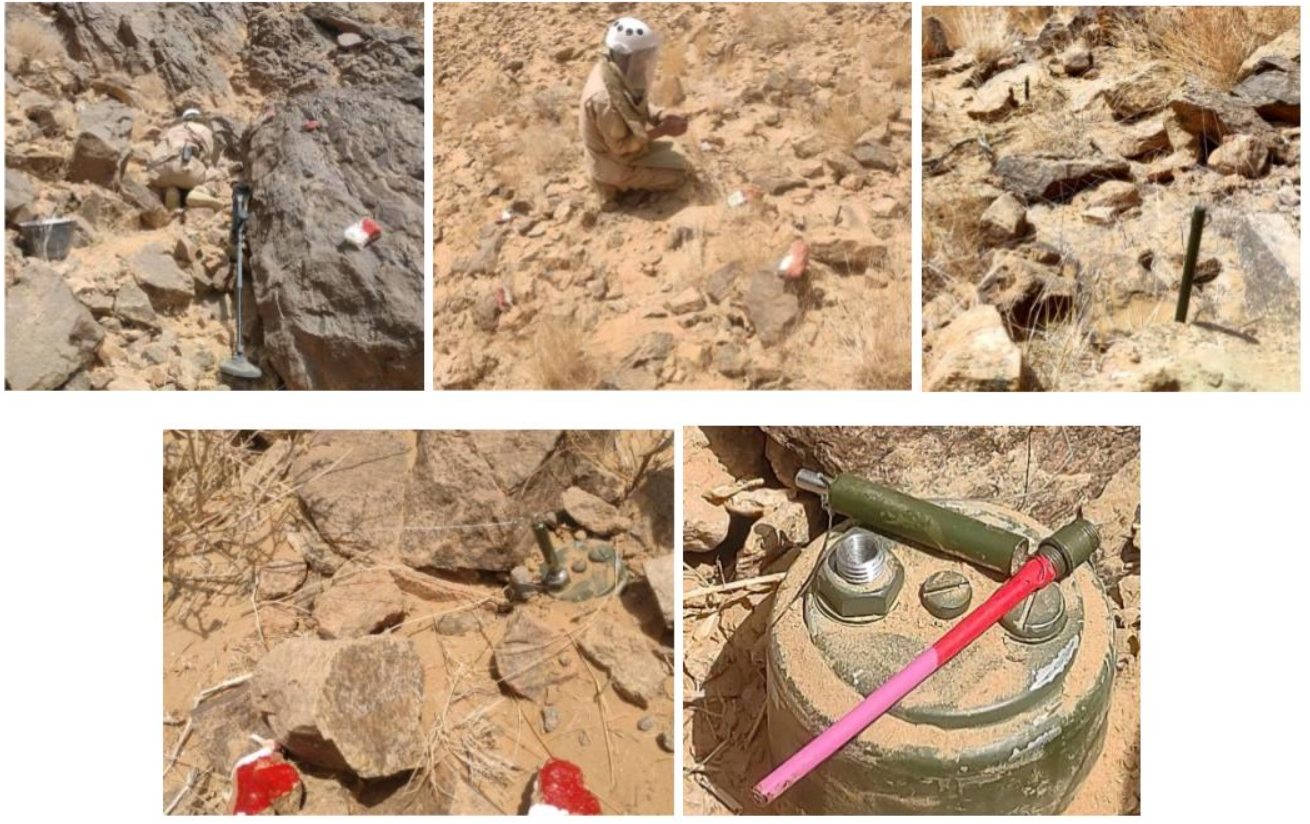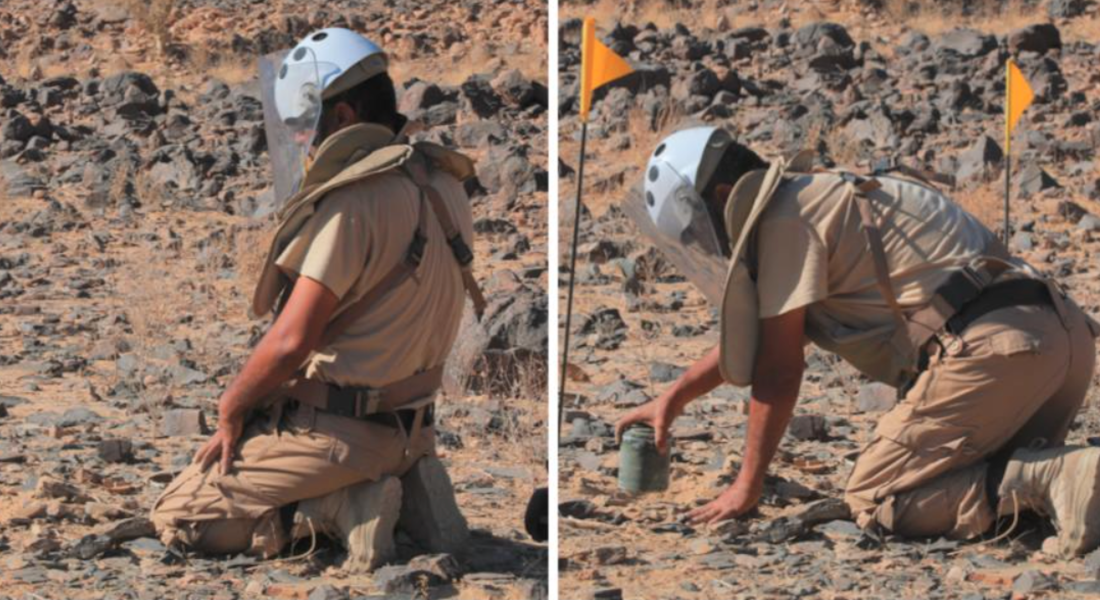A deep dive into bounding fragmentation mines. These banned deadly anti-personnel landmines that spray shrapnel at roughly waist height are now not only mass produced but ‘super large’ clones are now being discovered all over liberated areas of Yemen.
On Friday 19 May 2022, a deminer present at humanitarian landmine clearance programme Masam picked up the phone. On the other end was a chief of local security forces in Osilan Directorate in Shabwah province — one of the central frontlines in Yemen’s conflict between Houthi militias and pro-government forces.
The local chief was calling because he needed assistance with a possible improvised explosive device (IED) that had been spotted in his area of responsibility.
Masam’s Team 9 was immediately dispatched to the area to coordinate with the security forces and help locate and remove the IED.
However, after arriving at the location and clearing the suspected contaminated area, the deminers found not an IED as initially believed, but a bounding fragmentation mine that had been placed close to an access route leading to a village.
The bounding mine was connected to a remote initiation device, indicating that those who had placed it there wanted to target specific targets.
Once the team successfully removed the mine, they continued with their technical survey of the area.

‘Soaring numbers’
Since the Yemeni civil war began in 2014, the country has been awash with various types of landmines, IEDs and other remnants of war (ERW).
But while bounding fragmentation mines aren’t new — a small number of conventional anti-personnel (AP) bounding fragmentation mines from legacy Yemeni military stocks have been used by Houthi militants since at least 2014 — mine action experts say that their use has soared over the last four years.
“While these types of legacy mines have been found since the beginning of the project [mid-2018], during the four years of the project, the bounding fragmentation mines numbers have increased over the years,” Gus Maartens, Masam Project Manager, said from Aden.
More recently, it is well-documented that the Houthis have been mass producing their own improvised bounding fragmentation devices. Project Masam first encountered them in March 2021, but by January 2022 these new threats had been discovered in all frontline regions.
The recently liberated areas within the Governorates of Al Hudaydah, Al Jawf, Marib, Shabwah and Taiz — essentially all former Houthi held frontline territories — are today likely to be contaminated with large numbers of these threats, Masam warned in April 2022 during a panel discussion held in London for Mine Awareness Day.
Abdullah Abdul Jalil, Team Leader of Team 3, this week (14–20 May 2022) was called to clear a minefield located in Al-Hajfa region, Ain Directorate (Shabwah).
“The field contained a variety of mines; all of them are victim-operated by infrared, wires and are locally manufactured anti-personnel mines,” Jalil explained, adding that clearing this minefield is of utmost importance as it is connected to the main road between Harib and Ain Directorates, besides being very close to grazing and civilian areas.
“Previous explosions occurred here where livestock detonated the mines, and civilians lost some of their livestock. Immediately, the team went down, surveyed the area, and identified the minefield, then we cleared the mines by detonating them.”

New locally produced landmines
Civilians living near shifting frontlines have, in recent months, discovered tripwire-triggered versions of the bounding fragmentation mines.
“Over the last six months in Marib Area of Operations, these types of mines were found on a daily basis especially up in the mountainous areas as they can be concealed away from paths with tripwires crossing the paths which would be set off by a person or an animal walking up the path,” Maartens added.
The conventional mines, and the Houthi clones, can be triggered by multiple means, including tripwires, but also by the plethora of improvised switches that are available.
“To date, the Houthis have used pressure plate switches, tripwire mechanisms and radio command receivers as the triggers but it is likely that other trigger methods will be employed in the future,” an IED Threat Officer, who wished to remain anonymous, explained.
And these landmines can cause a lot of damage when detonated.
Indeed, their triggering mechanism causes a propelling charge within the bounding mine/device to generate high-pressure propelling gases. These, in turn, force the fragmentation charge to jump out of the ground, prior to its detonation at around waist to chest height, projecting hundreds of high-velocity metal fragments omni-directionally around the killing area.

Defensive landmines
There is nothing specific about the emplacement of these types of mines that suggests the Houthis are deliberately targeting civilians with bounding fragmentation devices — evidence shows that they typically employ other tactics in those scenarios.
They have, however, laid bounding fragmentation devices as ‘booby traps’ to target deminers that are clearing other threats, the IED officer said.
The IED Threat Officer explained: “For example, an unexploded bounding device was laid on the surface intentionally to appear as if it had bounded but failed to detonate. In the ground directly under the ‘failed’ item was a second bounding device connected to two AP pressure plates, which were intended to be triggered by personnel coming to deal with the ‘come-on’ device.”
In terms of Houthi operations, it does show that their intent has been to use explosive devices that can be better concealed as well as be triggered by a large variety of methods.
The different initiators (electrical initiators and mechanical percussion initiators) that have been developed specifically for use with these cloned bounding fragmentation devices show that they were designed with multi-role functionality in mind, similarly to their conventional counterparts.
“What is more significant is the Houthis’ development of larger variants of these cloned bounding fragmentation devices,” the IED officer said.
“The standard-sized variant is a clone of the 1950’s era, Czechoslovakian PP-Mi-Sr, anti-personnel mine, which contained around 325 g of TNT. The standard variant contains approximately the same explosive quantity; however, the two larger variants contain an estimated 1.75 kg and 10 kg of TNT, respectively, and these variants are discovered connected to the same triggering methods, described above, and are therefore significantly more lethal and will indiscriminately kill civilians and deminers at greater ranges.”
In recent months, Masam teams have found some of these more deadly landmines in riverbeds.


Harder to find mines
Are these new bounding fragmentation mines harder to spot?
“This depends on the terrain in which it is been used. Yes, it can be difficult to spot if a person was unaware of its presence in that area,” Marteens said, highlighting that those type of landmines are mainly used close to the Houthi frontlines, as well as placed in front of, or on the access paths up to, Houthi observation posts/ sniper positions or on the axis of advance of Coalition Forces.
Amongst other uses, the Houthis appear to be using the bounding fragmentation devices in circumstances where they would have previously deployed one of their improvised claymore-style directional fragmentation charges.
“The claymore style charges required to be emplaced above ground and are camouflaged as rocks, but to the ’trained eye’ are relatively easy to spot at a safe distance,” the IED offiecer explained.
The bounding fragmentation devices, by contrast, are emplaced below the ground and thus, are significantly harder to discover.
“If used with a tripwire it is possible to identify the tripwire and the firing mechanism, which are typically above ground, but the other electrical trigger methods can all be concealed below the surface and therefore can only be identified using a metal detector at zero stand-off. Removal is certainly more complicated than for a standard pressure-actuated AP mine, for example,” the IED expert added.

Removing deadly mines
The Render Safe Procedures (RSP) can be easy, or difficult, depending on the terrain.
“When our demining teams are working in such areas [former defense positions in mountainous areas] that are prone to have these types of devices, they will proceed with caution and follow set clearance procedures and look out for these mines.”
Marteens added: “It has been observed that the Houthis position their pressure plates to the side from which they suspect the Yemeni forces will approach from. It is therefore advantageous for deminers to identify the direction of previous Houthi locations and, where possible, clear the ground from the Houthi side.”
This tactic, he said, can allow the discovery of the explosive charges before encroaching on the switches.
These new findings all point to one evidence: the Houthis are still manufacturing large numbers of both improvised AP and Bounding mines — all of which are banned internationally.
“These mines have been left in areas [after troops’ withdrawal] where civilians have to move through, like in riverbeds, alongside roads and in mountains where the civilians have to take their sheep to graze,” Marteens said.
“To our understanding, as well as the areas in which the Houthis are using these mines, there isn’t any concern for a person’s life.”
While Marteens pointed out that Masam had not yet received any information pertaining to civilian casualties due to bounding mines, Team 9 and their colleagues vow to continue their life-saving clearance operations in liberated areas of Yemen.
This article was first published by Medium.

